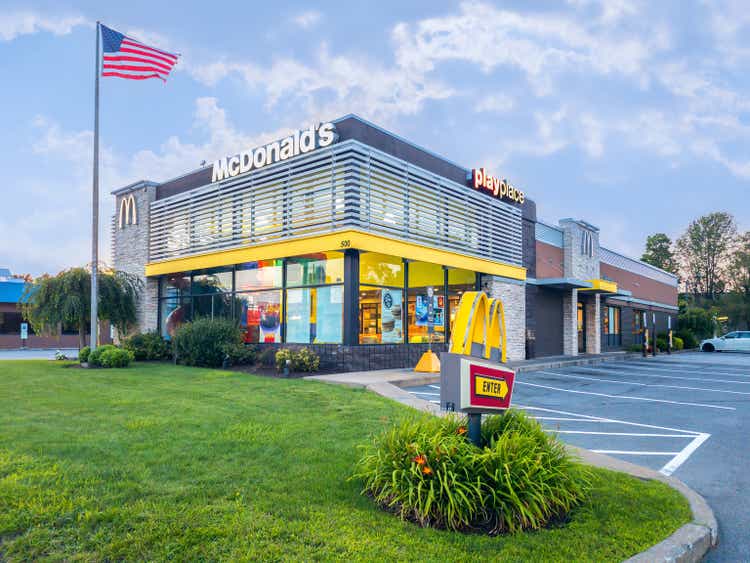Summary:
- McDonald’s shares hit a 5-year high but dropped 10% after an E. coli outbreak in Colorado and Nebraska, raising questions about buying opportunities.
- E. coli outbreaks are infrequent, but not rare; past incidents at other chains like Wendy’s saw share prices recover after initial declines.
- McDonald’s Q2 results showed minimal growth and stagnant cash flows; the company offers stable returns but lacks high growth prospects.
- Current valuation is high, with a P/E ratio of 27.5x; a further price drop could present a more attractive entry point for investors.
M. Suhail
This week, McDonald’s (NYSE:MCD) (NEOE:MCDS:CA) share prices reached a 5-year, and probably an all-time, high. And simultaneously, on the 22nd of October, the US’s Centre for Disease Control and Prevention announced that 49 people in Colorado and Nebraska have suffered from the E. coli bacteria after eating Quarter Pounder sandwiches at McDonald’s – including one death. This news sent the share price diving by 10% after the main market closed – although it recovered the following day to be done by only 5% by market close. The 5% discount is nice to have, but it does not tempt me yet to enter; valuation is too rich, and further discounts to the valuation would be needed.
Past E. coli outbreaks did break any restaurant businesses
E. coli outbreaks are neither common nor rare – over the past 40 years, they happened on average every 3-4 years on a noticeable scale in the US. Past cases have been limited to tens of infections rather than hundreds, and definitely not thousands. While any person falling ill is a case too many – these things tend to happen; food – whether in a restaurant or at home – will get infected every now and then.
A relatively recent case was in August 2022 when Wendy’s had an E. coli outbreak that affected 84 people in four US states. The share price fell by a total of around 10% in the following 8 weeks, then recovered to close 20% higher by the end of that year. Almost all other major fast food chains have faced outbreaks in the past 40 years.
With over 40,000 locations in 100 countries, it is very impressive that outbreaks of food infections are that limited to McDonald’s.
Performance is lackluster
McDonald’s has not published its Q3 results yet, but for a company like McDonald’s; quarterly results are unlikely to hide any fireworks. In the second quarter, total sales grew by a meager 1% globally, including a decline of 0.7% in the US market, while comparable sales fell by 1% globally. This was the first sales drop since 2020, and management blamed it on rising prices; the price of a Big Mac Meal increased by a third since 2019. This might not seem much over a 5-year period, especially with the rampant inflation the world has been facing post-Covid, but for price-sensitive McDonald’s customers; a 30% price increase is a lot. McDonald’s typical customer would expect prices of meals to freeze in time. Operating income decreased by 6%, and net income by 12%, reflecting absorption of the company for growing costs, and not passing on all cost increases.
There is no particular reason why McDonald’s share price should be growing more than average – and so it does not. Share price growth over the past 12 months was only 20% – half that of the S&P 500. Net income and operating cash flow generated in Q2 were stagnant compared to the previous year. Revenues only grew by 20% over the past five years. A shareholder of McDonald’s would not expect super growth but would expect stable and consistent returns.
And so is the case; over the past five years, the company increased dividend payouts by 30% and retired US$ 12 billion of shares. Annual capital expenditures consume only a third of operating cash flows, leaving plenty of free cashflows left for shareholders payouts.
Growth plans are ongoing, including plans to increase UK restaurants by 13% from 1,435 currently to 1,635. Continuing to grow the network is essential while working to revive like-to-like sales growth of existing restaurants.
Valuation bloated
With its incredible global reach, iconic brand, and unique operating efficiency, no one can argue that McDonald’s is not a stable and ‘safe’ business – transforming to a safe long-term investment. But the valuation today represents high growth prospects, which McDonald’s does not really demonstrate. A P/E ratio of 27.5x is higher than those of Alphabet and Meta, and equivalent to the P/E of the S&P 500. A market cap to operating cash flow of 25x is very rich. If the E. coil outbreak shaves a bit more of the valuation, a more attractive entry opportunity could be in the making for potential investors. At the moment, a Hold would be an appropriate positioning for investors until the company proves it can return to comparable sales growth, profitability growth, and a more attractive valuation is on offer.
Analyst’s Disclosure: I/we have no stock, option or similar derivative position in any of the companies mentioned, and no plans to initiate any such positions within the next 72 hours. I wrote this article myself, and it expresses my own opinions. I am not receiving compensation for it (other than from Seeking Alpha). I have no business relationship with any company whose stock is mentioned in this article.
Seeking Alpha’s Disclosure: Past performance is no guarantee of future results. No recommendation or advice is being given as to whether any investment is suitable for a particular investor. Any views or opinions expressed above may not reflect those of Seeking Alpha as a whole. Seeking Alpha is not a licensed securities dealer, broker or US investment adviser or investment bank. Our analysts are third party authors that include both professional investors and individual investors who may not be licensed or certified by any institute or regulatory body.
